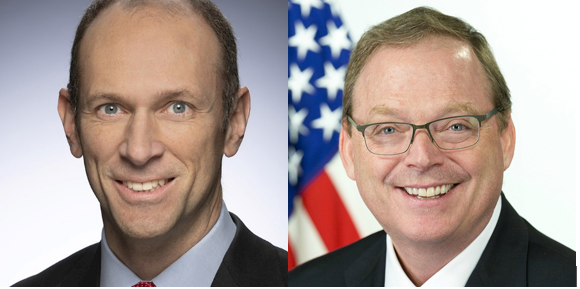
On September 15, the Stanford Institute for Economic Policy had a virtual discussion about both Covid-19 and the views of the two major presidential candidates. The moderator was Gopi Shah Goda, deputy director of, and senior fellow at, SIEPR and the two interviewees were Kevin Hassett, who had been chairman of the Council of Economic Advisers under President Trump and Austan Goolsbee, who had had the same job under President Obama.
I watched it live.
I’ll hit some highlights and make some comments. This is Part 1.
At 4;24, Goda asks: “What are the right economic policies to provide relief to those whose livelihoods have been adversely affected by the pandemic and stimulate the economy? How much spending should we do in the short run on Covid relief issues like extended and extra unemployment and stimulus payments?”
She started with Kevin, and I got my first big disappointment. Notice that she asked two questions. Kevin, though, answered only the second. He gave a big number for spending and didn’t mention any other means of relief: deregulating, letting people work in occupations without having to get a license, allowing restaurants to sell food, allowing restaurants to open, getting the FDA to allow people to use home tests for the coronavirus.
And his number for additional federal spending was big: $1.5 to 2.5 trillion.
Goolsbee’s answer was what I would have predicted: lots more federal spending and a big bailout of state and local government.
14:50: Kevin defines classical liberals like me out of the discussion with “I don’t think there’s anyone who thinks there shouldn’t be state and local aid.”
15:10: Austan gets it right: There are a great number of people who are opposing state and local aid.
17:10: Austan has a funny line that riffs on the old can opener joke: “This is not just ‘assume we have a can opener; let’s assume we have the greatest of all can openers.'” Then he says that you wouldn’t want to use the price system to allocate the vaccine.
23:43: Goda asks about the differences between the two candidates’ tax policies.
24:20: Austan says that Biden wants to raise taxes on high-income people and on corporations. What’s important, he says, is what the money is used for. If the added revenue were used to provide universal child care, that would be very pro-growth, says Austan.
But wait. This is not a discussion between politicians. This is a discussion between economists. What’s the market failure that would justify government provision of child care? Austan doesn’t even mention one. If my wife and I, when we were younger, had wanted to hire child care so she could work, we would have compared her after-tax income to our net-of-child-care-tax-credit cost of hiring child care. I showed in a piece in the Journal of Policy Analysis and Management in the late 1980s that the structure of the tax credit at the time could be seen as a way of offsetting the distorting high marginal tax rate of the second earner, typically the women. But Austan isn’t making that argument; in fact, for high earners, he wants an even higher marginal tax rate. Moreover, various changes in the tax law have been the tax credit much less pro-growth.
At about the 25:00 point, they get into a real substantive discussion about what happened to real wages and real family incomes after the tax cut. They literally disagreed about what the numbers were. Austan said that the effects of the tax cut on real median family incomes were disappointing. Kevin said that in a debate with Austan in Philadelphia a few years earlier, he had predicted that real median family income would rise by $4,000 and that the data that just came in (which were pre-pandemic), the number was actually a $4,900 gain. Kevin also pointed out that over 6 million people had moved out of poverty, the biggest drop since the War on Poverty had begun under LBJ. Kevin also pointed out that he had predicted that income inequality would fall as a result of the 2017 tax cut and that it had fallen.
Aside for non-economists: Why would reductions in income tax rates on corporations and on high-income individuals even be expected, at a theoretical level, to increase real wages? By increasing the incentive to invest in capital. The greater the capital to labor ratio, the higher are real wages.
29:10: Kevin catches Austan’s characterization of the proposed Biden tax hike as an increase in taxes on billionaires. Kevin points out that it would apply to people making over $400K annually. He then expresses optimism that Biden will hold off on raising marginal tax rates, due to the state of the economy.
31:00: Here is where Austan gives numbers on increases in real median family income that differ dramatically from Kevin’s data.
Aside: As a viewer, I was able to type a question on line and I did. We learned near the end from Goda that a number of viewers had asked a similar question and it was this: “You two are disagreeing on actual facts; show us your sources.” I asked Mark Duggan, the SIEPR director, for the source and he sent me the link to the Census data that Kevin had cited. Kevin turned out to be right about the large growth in median family income of families, including black and Hispanic families. I’m still scratching my head about what data Austan had in mind.
32:00: Kevin says that growth in median real family income in the first 3 years of Trump vastly exceeded any 3-year period under Obama.
32:10: Goda lays out the deficit issue nicely and asks about the two candidates’ plans.
In Part 2, I’ll cover the rest of the discussion.


READER COMMENTS
Robert
Sep 29 2020 at 11:36pm
Could someone expand on this a bit for me? Does investing in capital, mean investing in capital goods (i.e., land, machinery, tools, etc)? I don’t understand why that would necessarily lead to higher real wages.
Laron
Sep 30 2020 at 1:08am
The capital goods like machinery increase labor’s productivity, which increases wages. Others can chime in with more detail or to correct me tho.
Robert
Sep 30 2020 at 3:51pm
Thanks Laron. That was kind of what I was assuming was meant in the quote. I don’t know if I fully trust a business to return higher productivity back to workers in the form of higher salaries, but I can see how and why that could happen.
john hare
Sep 30 2020 at 4:55pm
you can attract better people with higher salaries and more motivated people make you more money. cheaping out on wages allows competition to pirate your best, leaving you with the less productive. but first it is necessary to make high enough profits to begin the virtuous cycle.
Comments are closed.